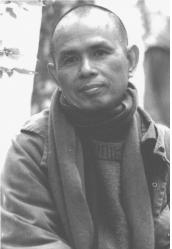 |
Thích Nhất Hạnh (born October 11, 1926) is a Vietnamese Zen Buddhist monk, teacher, author, poet and peace activist. He lives in the Plum Village Monastery in the Dordogne region in the South of France. His poems reflect his version of Engaged Buddhism. |
View: Thich Nhat Hanh Poems
Thich Nhat Hanh (pronounced Tick-Naught-Han) is a Vietnamese Buddhist monk. During the war in Vietnam, he worked tirelessly for reconciliation between North and South Vietnam. His lifelong efforts to generate peace moved Martin Luther King, Jr. to nominate him for the Nobel Peace Prize in 1967. He lives in exile in a small community in France where he teaches, writes, gardens, and works to help refugees worldwide. He has conducted many mindfulness retreats in Europe and North America helping veterans, children, environmentalists, psychotherapists, artists and many thousands of individuals seeking peace in their hearts, and in their world.
“Every day we do things, we are things that have to do with peace. If we are aware of our life our way of looking at things, we will know how to make peace right in the moment, we are alive.”
Thich Nhat Hanh
Thich Nhat Hanh has been living in exile from his native Vietnam since the age of forty. In that year of 1966, he was banned by both the non-Communist and Communist governments for his role in undermining the violence he saw affecting his people. A Buddhist monk since the age of sixteen, Tha^y (“teacher,” as he is commonly known to followers) earned a reputation as a respected writer, scholar, and leader. He championed a movement known as “engaged Buddhism,” which intertwined traditional meditative practices with active nonviolent civil disobedience. This movement lay behind the establishment of the most influential center of Buddhist studies in Saigon, the An Quang Pagoda. He also set up relief organizations to rebuild destroyed villages, instituted the School of Youth for Social Service (a Peace Corps of sorts for Buddhist peace workers), founded a peace magazine, and urged world leaders to use nonviolence as a tool. Although his struggle for cooperation meant he had to relinquish a homeland, it won him accolades around the world.
When Thich Nhat Hanh left Vietnam, he embarked on a mission to spread Buddhist thought around the globe. In 1966, when Thây came to the United States for the first of many humanitarian visits, the territory was not completely new to him: he had experienced American culture before as a student at Princeton, and more recently as a professor at Columbia. The Fellowship of Reconciliation and Cornell invited Tha^y to speak on behalf of Buddhist monks, and he offered an enlightened view on ways to end the Vietnam conflict. He spoke on college campuses, met with administration officials, and impressed social dignitaries. The following year, Nobel Peace Prize winner Dr. Martin Luther King, Jr., nominated Thich Nhat Hanh for the same honor. Hanh’s Buddhist delegation to the Paris peace talks resulted in accords between North Vietnam and the United States, but his pacifist efforts did not end with the war. He also helped organize rescue missions well into the 1970’s for Vietnamese trying to escape from political oppression. Even after the political stabilization of Vietnam, Thich Nhat Hanh has not been allowed to return home. The government still sees him as a threat-ironic, when one considers the subjects of his teachings: respect for life, generosity, responsible sexual behavior, loving communication, and cultivation of a healthful life style.
Tha^y now lives in southwestern France, where he founded a retreat center twelve years ago. At the center, Plum Village, he continues to teach, write, and garden. Plum Village houses only thirty monks, nuns, and laypeople, but thousands from around the globe call it home. Accommodation is readily available for short-term visitors seeking spiritual relief, for refugees in transit, or for activists in need of inspiration. Thich Nhat Hanh gathers people of diverse nationalities, races, religions, and sexes in order to expose them to mindfulness-taking care in the present moment, being profoundly aware and appreciative of life.
Despite the fact that Tha^y is nearing seventy, his strength as a world leader and spiritual guide grows. He has written more than seventy-five books of prose, poetry, and prayers. Most of his works have been geared toward the Buddhist reader, yet his teachings appeal to a wide audience. For at least a decade, Thich Nhat Hanh has visited the United States every other year; he draws more and more people with each tour, Christian, Jewish, atheist, and Zen Buddhist alike. His philosophy is not limited to preexistent religious structures, but speaks to the individual’s desire for wholeness and inner calm. In 1993, he drew a crowd of some 1,200 people at the National Cathedral in Washington DC, led a retreat of 500 people in upstate New York, and assembled 300 people in West Virginia. His popularity in the United States inspired the mayor of Berkeley, California, to name a day in his honor and the Mayor of New York City declared a Day of Reconciliation during his 1993 visit. Clearly, Thich Nhat Hanh is a human link with a prophetic past, a soft-spoken advocate of peace, Buddhist community, and the average American citizen.
Poems of Thich Nhat Hanh
- A Teacher Looking For His Disciple
- Be A Bud
- Drink Your Tea
- Kiss The Earth
- Looking For Each Other
- Sometimes
- To Meditate
- You Are Me
Links
- Plum Village – Buddhist Community of Thich Nhat Hanh
- Community of Mindful Living – Organisation promoting works of Thich Nhat Hanh
- Thich Nhat Hanh at www.seaox.com
- Buddhist Poets
- Spiritual Poets
- Contemporary Spiritual Poets
